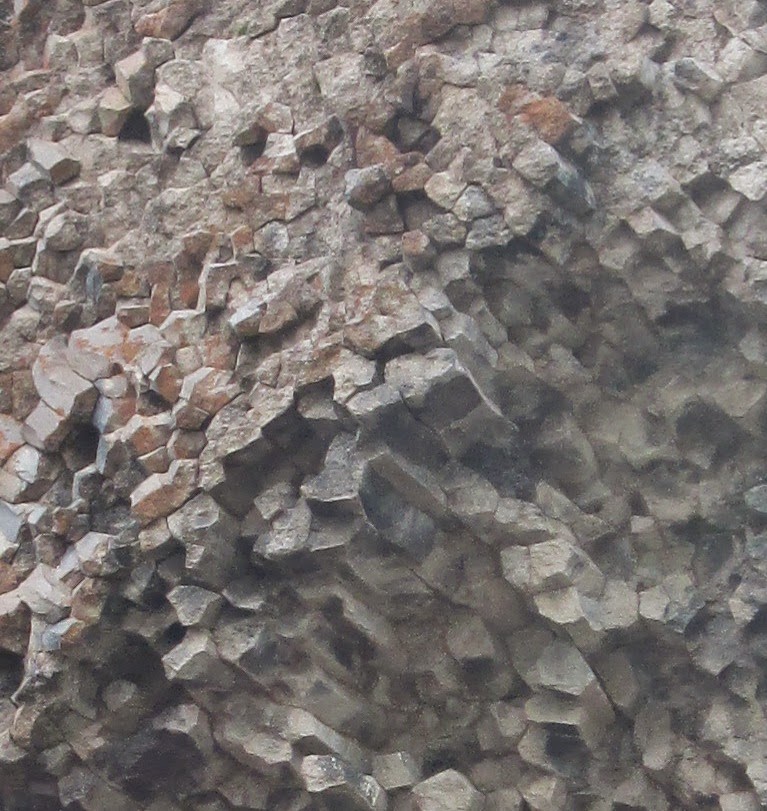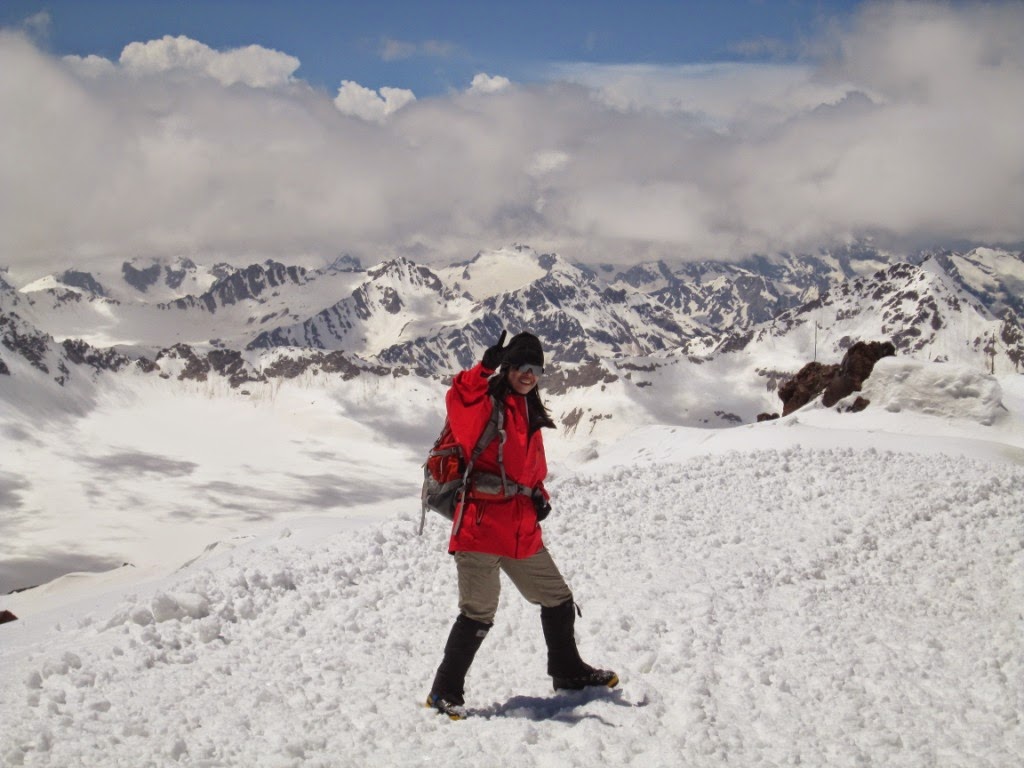 We are attached to the fixed rope as we
descend. Lavern and I have experience of this, but the other two do not.
Vladimir is attaching them to the top of the rope, which is awkward because
there seem not to be enough belay points, the rope seems to lie tight to the
ground and we if we had each been using two karabiners on short rope lengths
the manoeuvre would have been far easier. He says “Who did I give my gloves
to?” I wonder why he asks this question and then notice a pair of mittens
gracefully sliding and then whimsically gambolling down the slope towards the
saddle. Yet another vital piece of personal equipment gone and a temporary
glove keeper left mortified.
We are attached to the fixed rope as we
descend. Lavern and I have experience of this, but the other two do not.
Vladimir is attaching them to the top of the rope, which is awkward because
there seem not to be enough belay points, the rope seems to lie tight to the
ground and we if we had each been using two karabiners on short rope lengths
the manoeuvre would have been far easier. He says “Who did I give my gloves
to?” I wonder why he asks this question and then notice a pair of mittens
gracefully sliding and then whimsically gambolling down the slope towards the
saddle. Yet another vital piece of personal equipment gone and a temporary
glove keeper left mortified.
Once at the end of the fixed rope we rope
up together and Vladimir asks if I will lead down towards the saddle – which I
am happy to do. After 10 or so minutes Vladimir bounds past us and heads at
break-neck speed down towards the saddle and I realize that he is after a spare
pair of gloves left in his rucksack before his hands seize with frostbite.
We’re traversing, un-roped in a slow descent below the saddle.
Vladimir is leading, followed by Moegammad. Then me followed by Ganief and as
directed by Vladimir, Lavern is bringing up the rear. We are in a white-out
conditions and visibility is between 10 – 15m and the there is no discernible
distinction between snow and horizon. I am struggling to see the footprints
left by Moegammad in front of me and I am following his progress almost by
intuition along a traverse that is probably at an angle of 40 or so degrees. I
hear Lavern shout “Steve.” I turn and see Ganief face down in front of her in
the snow. He is immobile. I know he has been taking tremendous strain and am
somehow not surprised. I shout “Vladimir!” Vladimir who is barely visible,
immediately turns back.
Initially Vladimir ropes himself to Ganief,
but I am concerned about the poor visibility, the steep slope that we are
traversing and the fact that we had already become uncomfortably strung out
before Ganiefs temporary collapse. I ask
Vladimir how long this traverse is likely to take – and he says a long time. I
suggest that we should be roped together, and after much agonising manoeuvring
and shouted instructions from Vladimir that’s what happens.
_______________________________________________________________________
_______________________________________________________________________
 Clouds are pretty amazing wherever you are and
if you can be bothered to look up for long enough. For probably obvious reasons clouds seen at
altitude have a greater clarity. It is not I think just because the air quality
adds to cloud photogeneity but romantically because one is closer to the point
where clouds are actually forming.
Clouds are pretty amazing wherever you are and
if you can be bothered to look up for long enough. For probably obvious reasons clouds seen at
altitude have a greater clarity. It is not I think just because the air quality
adds to cloud photogeneity but romantically because one is closer to the point
where clouds are actually forming.
As we are descending I promise myself to
remember the cloud forming above me. I am too tired and cold to stop and take
out my camera. The cloud above me is performing slow gambols that are begging
to be described in terms of earthly experiences. Forests are standing on their
heads, pigs are smoking their own socks, wistful fairies are leaning down
towards me, and gilded mushrooms are reaching out . . . . Jet stream winds are
conspiring with temperature gradients and saturation points to create filigree
intemperate and wild ephemeral sculptures that only I (and my companions) can
and ever will see.
These are private moments; a very personal gallery that is
unique and ever changing. Earlier I've watched a classic lenticular cloud
formation settle into the middle horizon, extensive and embracing, defining the
horizon; somehow solid even though it is ‘merely’ cloud. In contrast the cloud
above us now is small and contained, almost insular as it clown dances within
its own defined space, creating its own shape within its own time; the sock
smoking pig loses its wig and transmogrifies into stand of pine trees . . .
And as I now write this I am oddly glad
that I have no photographs because my now sharpened memory would be dulled and
adulterated by poor two dimensional visual reminders . . . . and the trip would
have been badly misremembered.
_____________________________________________________________________
We have descended to 5,000m or so. Vladimir
has phoned for a skidoo to pick us up. We are variously sitting and lying in an
area of broken snow and ice that has been churned up by previous skidoo
activity. We are terribly tired. The roped frog march to this point has been agonizingly
slow and the incidents of missed footings increasingly frequent. It is late on
Sunday. Most of the Skidoo drivers have knocked off, and who can blame them?
A
second phone call confirms that the skidoo will not ascend this high. It
(they?) will meet us at 4,700m. Another 300m agonizing descent looms. It is
late afternoon, which after a 5am start means that this has been an achingly
long day already. Below us as we stumble down the snow slopes we see a skidoo
progressing across the snow towards the 4,700m mark which is at the top of the
Pastukhov Rocks. Ganief has found new energy and is surging ahead following
Moegammad and Vladimir who are well in front. Vladimir has placed Lavern at the
rear of the group as sweeper. From above I see that Moegammad reaches the
skidoo first and obviously instructed by Vladimir mounts the vehicle along with
a spare rucksack and the skidoo takes off. From above I watch Ganief stop 50 or
so metres away from the departing skidoo. From 100m behind him I feel that his
back is expressing absolute dejection, perhaps even despair as the skidoo
speeds away down towards warmth and safety. But perhaps I am merely imagining
how I would feel in that situation.
I don’t know how long we wait before I
suggest to Vladimir that he might like to phone again to find out what is
happening with the skidoo. I feel the cold beginning to invade my clothing I
have been in colder conditions but never have I felt so exposed –and despite
(but perhaps because of) the surly unyielding presence of Vladimir so alone;
and I begin to worry about hypothermia. How long does one wait before taking
some sort of action? What sort of action? I cannot face walking another
faltering downhill step. Downhill snow walking is at that moment the most
exhausting activity I can think of and I cannot, I will not keep doing
it. The colours of the landscape are becoming sharper as dusk grey blues and
sunset pale yellows and oranges surge across the sheer mountain walls across
the valley, chased by swift and lowering clouds. The sharpness of the canvas is
reflected in the dropping temperature. The cold is beginning to seep into my
soul.
Vladimir says that we must walk down to the
base of the Pashtukov Rocks. “This I cannot do,” I complain. He gives me his
spare walking pole and ignoring my whimpering he sets off down the further 100m
descent to the base of the Pashtukov Rocks. My thighs, buttocks and knees are a
dull mass of pain and my mind is numb. On later reflection it was far better
that we were actually moving although at the time I was detesting everything
about my condition and was swearing at Vladimir’s rapidly descending back.
____________________________________________________________
____________________________________________________________
I have survived the most bone crunching skidoo
ride imaginable. The vehicle arrived as I stumbled down the last few metres to the
base of the Pashtukov Rocks. Vladimir told me to mount the machine – as if I
needed any encouragement – and said he was going to walk down the remainder of
the way by himself.
I stand at the Barrels and look up at the mountain,
which looks benign, almost gentle – certainly unchanging. From 3am this morning
to now, 8pm this evening, it’s been a full day of intense effort, hardship, emotional
extremes, and all sorts of other disjointed experiences.
It’s okay. We've achieved what we set out to do, and are better for it, but it will be some time before it all comes into focus and makes sense; probably much later. Now is the time to get food, hot liquid, lots of talk; and rest.



































